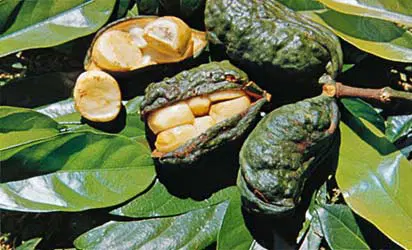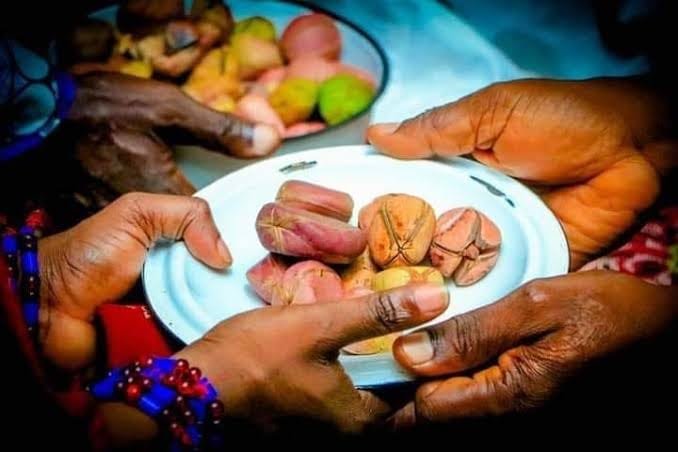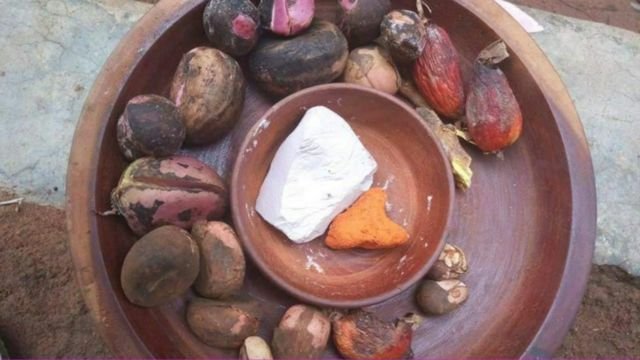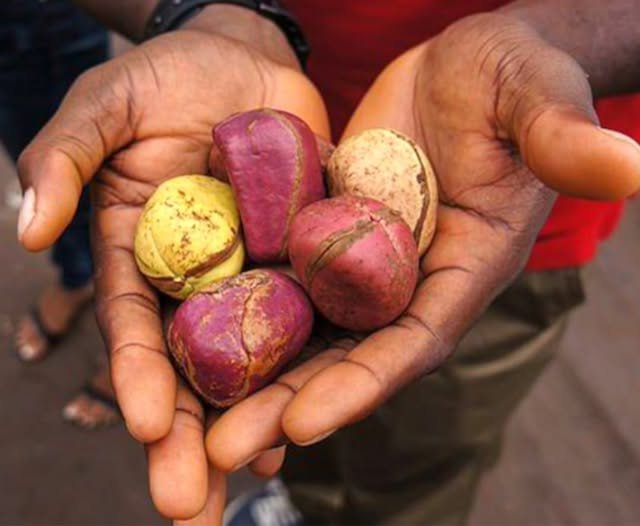In the lush, emerald rainforests of southeastern Nigeria, where ancient traditions pulse like the heartbeat of the earth, one unassuming fruit reigns supreme: the kola nut, known to the Igbo people as Oji Igbo. Far from the fizzy, caffeine-laced sodas it inspired in distant lands, this bitter, lobed seed is a living emblem of life, peace, and unbreakable communal bonds. “Onye wetara oji wetara ndu” – “He who brings kola brings life” – whispers an age-old Igbo proverb, encapsulating the essence of a ritual that has withstood centuries of change, from colonial shadows to modern globalization.
Imagine arriving at an Igbo home as a weary traveler. Before words of greeting or plates of steaming fufu, you’re offered a wooden tray bearing this humble nut, its reddish-purple shell cradled like a crown jewel. This isn’t mere hospitality; it’s an invitation to the soul of Igbo identity. In this blog post, we’ll journey through the layers of Oji Igbo – its origins, rituals, symbolic power, and enduring relevance – revealing why this sacred seed continues to nourish not just bodies, but entire cultures.

Roots in the Rainforest: The Origin of Oji Igbo
The kola nut hails from the Cola acuminata tree, a towering native of West Africa’s tropical lowlands, thriving in the humid embrace of Igboland. Unlike its paler cousin, Cola nitida (derisively called gworo by the Igbo and dismissed for rituals), Oji Igbo is the only variety deemed worthy of spiritual reverence. Its seeds, naturally splitting into two to eight lobes, carry the weight of myth and necessity.
Igbo lore traces the nut’s divine inception to the dawn of creation. Legends speak of it as the first fruit on earth, planted by the gods themselves as a bridge between the mortal realm and the ancestors. One captivating tale recounts Ugo Onobo, the primordial woman whose bride price was paid in kola, birthing the rare white-lobed Oji Ugo – a variety so exquisite it’s likened to the elusive eagle feather. The tree’s wood is never burned for fuel, a testament to its sanctity; even in death, it commands respect.
Botanically, the kola nut’s caffeine jolt once fueled laborers across the continent, staving off hunger and fatigue. But for the Igbo, its true potency lies in the cultural soil from which it springs – a symbol of resilience, mirroring a people who have turned adversity into art.
The Ritual of Breaking: A Dance of Words and Unity
No Igbo gathering – be it a village palaver or a joyous wedding – unfolds without the Iwa Oji, the ceremonial breaking of the kola. This isn’t a casual snack; it’s a meticulously choreographed rite, where every gesture weaves threads of harmony.
Picture the scene: The host, often the eldest man or Eze (traditional ruler), receives the Okwa Oji – a carved wooden dish holding the nuts, flanked by alligator pepper, garden eggs, and perhaps a dash of okwa ose (spicy peanut butter). Women, in a nod to deeply rooted gender roles, rarely plant or break the ceremonial kola, though they partake freely in female-only circles. The tray circulates clockwise, a symbolic headcount ensuring no voice is silenced, before returning to the elder with the chant: “Oji Eze n’en Eze n’aka” – “The king’s kola returns to the king.”

Then comes the sacred Igo Oji: prayers in pure Igbo tongue, for Oji “does not understand English.” The elder invokes Chineke (the Supreme God), ancestors, and deities, offering a lobe to the spirits. A piece is broken – never with a knife, lest it sever bonds – and savored first by the elder, dipped in pepper for flavor and fortune. The rest is shared communally, sealing a covenant of trust. Mistakes here? A fumbled pass invites whispers of unreliability; perfection affirms one’s place in the circle.
This ritual transcends the mundane. In Chinua Achebe’s Things Fall Apart, kola appears tenfold, underscoring its pre-colonial heartbeat: a harbinger of discourse, where nuts are broken before truths are spoken.
Lobes of Fate: Decoding the Nut’s Prophetic Language
What elevates Oji Igbo from fruit to oracle? Its lobes – those natural cotyledons – each whisper prophecies, turning a simple break into a communal fortune-telling.
- One lobe: Oji Onye Ichi (Kola of the solitary) – a dire omen, evoking isolation or misfortune. Rarely seen, it’s cast aside like a curse unspoken.
- Two lobes: Oji Mmuo (Spirit’s kola) – another taboo, linked to duality’s shadows, like the tragic infanticide of twins in ancient lore. It’s for spirits alone, untouched by human hands.
- Three lobes: Oji Ike or Oji Ikenga (Kola of the valiant) – reserved for warriors and the bold, symbolizing strength and resolve. Only the consecrated dare partake.
- Four lobes: Oji Udo na Ngozi (Kola of peace and blessing) – the gold standard, mirroring Igboland’s four market days (Eke, Orie, Afo, Nkwo). It heralds harmony, prosperity, and the gods’ favor.
- Five or more: Up to eight lobes signal abundance; six might demand a goat sacrifice in celebration, as if the earth itself overflows with grace.
These divisions aren’t random; they’re a philosophical map, aligning the physical with the spiritual. The four-lobed ideal? It embodies Igwebuike – “strength in unity” – a core Igbo axiom where community trumps the individual.
Threads of Tradition: Kola in Igbo Ceremonies
From cradle to grave, Oji Igbo threads through life’s tapestry, a constant in flux.
In weddings, it’s the ultimate emblem of union. Families exchange trays as a pledge of goodwill, the breaking sealing alliances with prayers for fertile fields and fruitful homes. Funerals honor the departed without full rhetoric, a quiet nod to transitions beyond. Disputes? A shared kola mends fences, its bitterness a reminder that peace often follows trials. Even child dedications or housewarmings begin with this nut, invoking blessings for new beginnings.
Yet, its reach extends further. In literature, from Achebe to Chris Abani’s GraceLand, kola symbolizes cultural endurance amid upheaval. Globally, it’s the unsung hero of cola empires, though modern recipes have long forsaken its extract for synthetic fizz.
Beyond the Bowl: Challenges and a Call to Preserve
Today, as urbanization nibbles at rural groves and climate whispers threats to the kola tree, the ritual faces quiet erosion. Younger generations, adrift in diaspora dreams, sometimes view it as quaint relic. Yet, in Igbo festivals worldwide – from Atlanta’s New Yam celebrations to Lagos’ cultural revivals – Oji endures, a defiant root against cultural amnesia.
Preservation isn’t nostalgia; it’s survival. Reviving kola rites fosters identity, teaching youth that true wealth lies in shared stories, not fleeting trends. Plant a tree, learn the prayers – let Oji Igbo remind us: in a divided world, what binds us is often as simple (and profound) as a seed.
A Bitter Blessing for Tomorrow
As the last lobe dissolves on the tongue – bitter, invigorating, eternal – Oji Igbo leaves you changed. It’s more than a nut; it’s a philosophy, a covenant, a lifeline to ancestors. In the Igbo worldview, where life unfolds in cycles of four, this sacred seed teaches that peace isn’t given – it’s broken open, shared, and savored.
Next time you sip a cola, pause. Taste the echo of rainforests, rituals, and resilience. And if fate brings you to Igboland, accept the tray with open hands. You’ve just been handed life itself.
What rituals from your culture bring people together? Share in the comments – let’s break bread (or nuts) across borders.

Sources: Insights drawn from Igbo cultural archives, including chiism.org, igboness.com, and scholarly works on Igbo traditions
